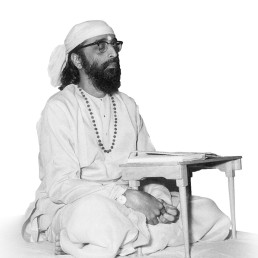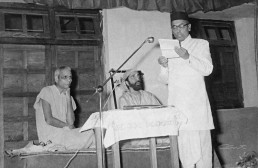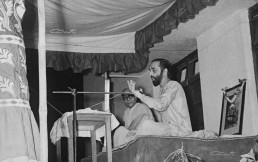
Jnana Yajna 39

Year & Dates:
April 24, 1958 to May 10, 1958

Yajna Topic:
Shrimad Bhagavad Gita- Chapter 2

Place:
Aurangabad, India.
A gentle drizzle just before the inauguration of the 39th Jnana Yajna at Aurangabad, Maharashtra – it seemed like Varuna, the God of Rains, wanted to participate in Pujya Gurudev’s Gita Jnana Yajna. Unmindful of those sprinkles, an attentive audience awaited the glorious Chapter 2 of Bhagavan Krishna’s Eternal Song through the incomparable voice of Pujya Gurudev Swami Chinmayananda. After prayers at the nearby Khadkeshwar Shiva temple, the unfurled Om flag energized the atmosphere. Sri B. G. Ghate, the secretary of the yajna committee welcomed Pujya Gurudev and the gathering. And, Swami Ramanand Thirth inaugurated the yajna saying Gita showed the way to lasting happiness.
Opening His address with, “In this red-hot age of Sputniks and Hydrogen bombs, in this age of Science and Technology, in this age of Plans and Projects, you may be wondering why there are two Sadhus on the stage this day!” Pujya Gurudev attracted Aurangabad with His charming wit.
Through Heat and Rain
As Pujya Gurudev shifted into high gear in the discourses that followed, Nature too became intense. Aurangabad experienced an unusual heat wave, and then the skies poured. When the yajna committee tried to put up a shamiana (tent), their efforts were thwarted. Every evening, a storm brought down the new tent that had stood through a quiet day after being erected. Undisturbed by the onslaught of heat and rain, storm and thunder, Pujya Gurudev unfolded the exalted logic of Sankhya Yoga and Buddhi Yoga. Sheltered by His composure and immersed in the beauty of His exposition, the audience sat thrilled by the spiritual, intellectual, ethical, and traditional viewpoints that Pujya Gurudev presented.
Aurangabad is home to many artistic masterpieces. During this Jnana Yajna, Pujya Gurudev visited the acclaimed Ellora Caves, about 18 miles from Aurangabad. The aesthetic excellence of the Kailas Cave, in particular, launched Him into a state of supreme joy.
During the final days of the yajna, the Akhanda Kirtan from April 30th, the Gita Homa from May 2nd, and the Gangajal procession stirred devotion in all the awakened hearts of Aurangabad. The spiritual sojourn to the nearby town of Paithan and the Avabhruta Snanam in the Godavari river brought much happiness to devotees. Offering homage at the Samadhi shrine of the great saint of Maharashtra, Sant Eknath Maharaj was a fitting culmination. Pujya Gurudev, in yet another wonderful Jnana Yajna, demonstrated how the Gita view of life can certainly become a practical way of life.
Photo Gallery

“Think,” Says Pujya Gurudev
Yoga and Kshema in their meaning include all the activity of every living being on the face of the universe. These are the two urges which goad every one in all their activities. Yoga means ‘to acquire’ for the purpose of possessing them; and ‘kshema’ means ‘all efforts at preserving the acquired’. Thus the two terms Yoga and Kshema indicate all our ego-centric activities motivated by selfish desires to acquire and, compelled by equally selfish wishes, to hoard and preserve what has been acquired. To renounce these two temperaments is to immediately get away from the two main fields that yield the poisonous harvest of extreme restlessness and sorrow in life.
From Tyagi Magazine
Buddhi as defined in the Upanishad is a determining factor in the inner equipment; Nischayatmika is intellect; Samsayatmika is mind. Thus, when thoughts are in a state of flux and agitated it is called the mind; and when it is single-pointed, calm and serene in its own determination, it is the intellect. Thus Buddhi Yoga becomes “established in the devotion to intellect.” Steady in your conviction, your mind perfectly under the control of your better discriminative intellect, to live a master of your inner and outer work is called Buddhi Yoga.
From Tyagi Magazine
Embrace Death
Explore the profound wisdom behind the metaphor of death as a mere change in attire. In this insightful discourse, discover how the transition from one body to another is likened to shedding old clothes and donning new ones. Gain a deeper understanding of the timeless concept of mortality and the continuity of existence beyond physical form. Join us on a journey of contemplation and enlightenment as we delve into the eternal nature of change.

